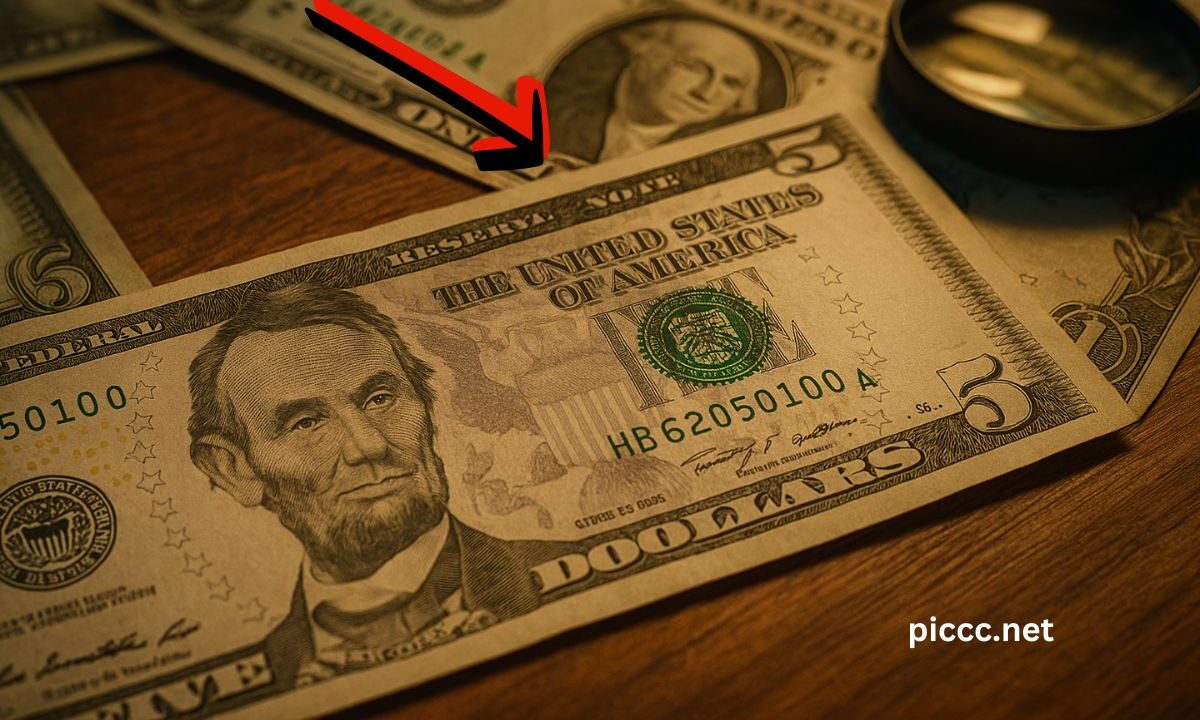Most $5 bills are worth face value, but certain fancy serial numbers and printing errors can skyrocket prices.
Collectors pay premiums for patterns like solids (e.g., G88888888A), radars (AB12344321BA), and perfect ladders (12345678), and even more for dramatic error notes such as mismatched serial numbers or double-denomination pieces (a $5 with a $10 back).
Verified auction results show $5 error notes routinely bringing five figures, with a celebrated 1934-D $5/$10 double denomination realizing $55,200 in 2022.
Quick value table: serials & errors to look for
| Feature on a $5 bill | What it looks like | Typical market potential* |
|---|---|---|
| Solid serial | All digits the same (e.g., G88888888A) | $1,000+ depending on grade and demand. |
| Ladder serial | 12345678 (or 87654321) | Often $900–$1,900 in strong grades. |
| Radar / Super-radar | Palindrome like A12344321A | Hundreds to low thousands, condition-dependent. |
| Low serial | 00000001–00000100 | Premiums vary widely; top pieces bring four figures. |
| Star notes | Star ★ after serial | Scarcer runs/grades bring hundreds to thousands. |
| Mismatched serial error | Top/bottom numbers don’t match | Thousands; select examples have topped $9,000. |
| Double-denomination error | $5 face with a $10 back | Regularly $20,000–$55,000; elite examples exceed $50k. |
*All values are recent guide/auction indications; exact prices depend on grade, rarity, and demand.
About that “$76,000” headline
Headlines often cite $70k+ to reflect the upper edge of what elite paper-money rarities can fetch. For $5 bills, the most publicized, well-documented top results are double-denomination 1934-D $5/$10 errors selling into the $50,000s at major auctions; exceptional pedigree/grade pieces can push higher. Treat $76,000 as an exceptional best-case number—not the norm.
How to check your $5 bill (fast)
- Read the serial number: Look for solids, ladders (12345678), radars (AB12344321BA), repeaters (ABABABAB), or very low numbers. A quick way to screen patterns is to use a serial checker tool.
- Scan for errors: Are the two serials identical? If not, you may have a mismatched serial. Check for missing digits, misaligned overprints, or anything that looks like a $10 back on a $5 front (double-denomination).
- Condition is king: Crisp, uncirculated notes (PMG/PCGS Gem) bring multiples over circulated examples.
- Authenticate before selling: For anything unusual, submit to PMG or PCGS Banknote and consider consigning to a major auction house with error-note expertise. Auction archives are the best barometer of real market prices.
Pro tips to maximize value
- Don’t press, wash, or flatten the note—cleaning kills value.
- Keep it in an archival sleeve until graded.
- When in doubt, compare with auction archives for similar serials/errors and grades.
While most fivers won’t change your life, the right serial number or dramatic printing error can turn a $5 bill into a five-figure payday.
Perfect ladders/solids and authenticated error notes—especially the iconic 1934-D $5/$10 double denomination—are the proven headline makers, with verified results surpassing $50,000 and, in exceptional circumstances, pushing higher. Check your wallet—you might be holding a sleeper.
FAQs
Which serial numbers on $5 bills are most valuable?
Solids, ladders, radars/super-radars, repeaters, very low numbers, and scarce star notes—especially in uncirculated condition.
What $5 error brings the biggest money?
The 1934-D $5/$10 double-denomination is the category’s “king,” with auction prices over $50,000 for certified gems.
How do I sell a valuable $5 bill?
Get it certified (PMG/PCGS), then consign to a major auction house with strong error-note buyer traffic to maximize competition and price.

